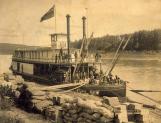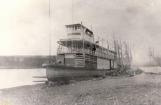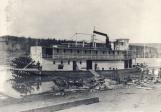1
The largest business enterprise on the Peace River in the early 20th century was the Hudson's Bay Company [HBC], which had a series of trading posts and retail stores along the river and inland. Prior to 1905 the HBC did not use steamboats on the upper Peace River, insteading utilizing scows and rafts for moving freight and staff on the river. The only access to steamboats was at the Vermilion Chutes where the S.S. Grahame, a HBC steamboat, landed 3-4 times per year. That was all to change after the launch of the St. Charles by the Oblates at the St. Augustine Mission in 1903.2
The S.S. Grahame on the Athabasca River.Post 1883
Athabasca River, Alberta, Canada
 Credits:
Credits:Peace River Museum, Archives & Mackenzie Centre, 87.1506.007
3
The launching of the S.S. St. Charles in May 1903 was a major concern to the HBC in regards to their economic supremacy on the Peace River. The Oblates, in addition to carrying their own members from mission to mission, also used their steamboat to carry freight and passengers on the entire length of the river from Fort St. John to the Vermilion Chutes. They clearly wanted to utilize the S..S.St. Charles in a business fashion in order to generate revenue for their missions. This action was not acceptable to the HBC for a number of reasons: the S.S. St. Charles might take business away from the HBC by providing freight service; the S.S. St. Charles might allow the Oblates to sell lumber from their mill at the St. Augustine Mission more competitively with the mill at the HBC post at Fort Vermilion; the HBC might become dependent on the Oblates for transportation services (a complete role reversal); and perhaps most importantly, the arrival of the S.S. St. Charles might be the first of several other steamboats built by the HBC's competitors.The HBC response to these concerns was to create a "fleet" of steamboats on the upper Peace River. This "fleet" was to consist of their own larger stern-wheeler, the S.S. Peace River, and a steam tug, the Messenger.
Note:
There is a great deal of information on the decision of the HBC to use steamboats on the upper Peace River in:
Hudson's Bay Company Archives, Archives of Manitoba. A.12/FT341/11 'Peace River Transport and Navigation, 1903.'
4
The S.S. Peace River.Circa 1905
Peace River Crossing, Alberta, Canada
 Credits:
Credits:Peace River Museum, Archives & Mackenzie Centre, 75.622.006
5
The major component of the upper Peace River "fleet" was to be the S.S. Peace River. In 1903 the HBC asked the Marine Iron Works in Chicago to design a boat suitable for use on the upper Peace River. In discussions with HBC staff the Marine Iron Works came up with a sternwheel design that utilized two paddle-wheel marine engines. The boat, 110 feet in length and 24 feet wide, came from designs found in other North American river systems. Its design included two decks and provided berths for passengers as well as space for freight.The S.S. Peace River was built at the HBC post at Fort Vermilion where wood for the boat could be cut at the Company sawmill. The builder, Alex Watson, assembled the boat (with the engines, boilers and other components shipped from Chicago) during the winter of 1904-5. The S.S. Peace River was launched in the spring of 1905.
6
The S.S. Peace River "drydocked" at Peace River Crossing.Circa 1915-6
Peace River Crossing, Alberta, Canada
 Credits:
Credits:Peace River Museum, Archives & Mackenzie Centre, 75.622.062
7
The S.S. Peace River, like all of the steamboats to be used on the upper Peace River, utilized cut dry wood as its primary fuel. In addition to standard boat staff the S.S. Peace River also had to include men to cut (on occasion) and load wood from the banks of the Peace River. The S.S. Peace River could use as many as 300 cords of wood in a season and had to carry several cords at a given time.8
Loading wood on the S.S. Peace River.Circa 1905-1915
Peace River Crossing, Alberta, Canada
 Credits:
Credits:Peace River Museum, Archives & Mackenzie Cente, 81.1197.003
9
One feature that was introduced to the design of the S.S. Peace River was the cutting and hinging of its smokestack in 1908. At that time a ferry was introduced at Peace River Crossing that ran on a series of cables across the river. The S.S. Peace River was unable to go under or over the cable: the only solution was to modify the smokestack so that it could be lowered to go under the ferry cable.10
The S.S. Peace River.Circa 1908-1915
Peace River Crossing, Alberta, Canada
 Credits:
Credits:Peace River Museum, Archives & Mackenzie Centre, 81.1197.002
11
Descriptions of travel on the S.S. Peace River are provided by passengers including Mary Lawrence (1907), Katherine Hughes (1909) and L.V. Kelley.12
A description of embarking on the S.S. Peace River from Fort Vermilion in 1907.July 1907
Fort Vermilion, Alberta, Canada
In 1907 Mary Lawrence describes the departure of her family aboard the S.S. Peace River from their home at Fort Vermilion:
"The last morning, opening brightly in July, Fred [Lawrence] took us across river and drove us the seven miles by buckboard to the Hudson's Bay Company's Post, to the steamer [S.S. Peace River]. During the previous days we had been getting our things together. We were used to travel and ready to leave. The steamer was whistling. We pulled away from each small familiar sight with a wrench of something uprooted. One moment we were calling good-by to Fred and then we were passing the first point, rounding out of sight. Smoke shadow and wake wove and blended, braided and unravelled as the wind and course shifted. Already the children had forgotten! Already they were inspecting a strange wonderful new world! Their minds gasped with the thought of it!"
Mary B. Lawrence, quoted from: Wilderness Outpost: The Fort Vermilion Memoir of Mary B. Lawrence, 1898-1907., edited by Marilee Cranna Toews. Edmonton: The Alberta Records Publication Board, Historical Society of Alberta, 2008, pp. 209-210.
In this colorful description Lawrence clearly links the use of a steamboat on the Peace River with the "strange wonderful new world" of the early 20th century.
Credits:Marilee Toews, editor. Wilderness Outpost., pp. 209-210.
13
Katherine Hughes' description of travelling on the S.S. Peace River in the summer of 1909.July 1909
In the summer of 1909 Katherine Hughes travelled on the S.S. Peace River. In her journal for her journey she describes typical activities on the steamboat:
" Each two hours the steamboat bell rings four times for the deckhands to go and pile wood into furnace, and then afresh the cinders come out with a rush and the smell of wood fire ascends to our deck--Likewise the heat of it.
The meals are served as for a family. Purser at one end, Captain at other, the other serving the food.
We had:
Bread made from Peace River wheat at Vermilion Mills.
Butter made from Peace River cream.
Potatoes.
Alll waiting to rise from meal together. A young Metis serves the meals and acts as Steward. Good while linen, etc."
In the Promised Land of Alberta's North: The Northern Journal of Katherine Hughes (Summer 1909)., edited by Ken Kaiser and Merrily Aubrey. Edmonton: Alberta Records Publication Board, Historical Society of Alberta, 2006, pp. 35-6.
Credits:Ken Kaiser and Merrily Aubrey. Promised Land., pp. 35-6.
14
A description of the S.S. Peace River leaving Peace River Crossing.August 1910
Peace River Crossing, Alberta, Canada
In the summer of 1910 a reporter for the Calgary Herald, Leroy Victor Kelly, boarded the S.S. Peace River at Peace River Crossing for a trip to Fort Vermilion. After waiting for the boat to return from taking on wood as fuel Kelly notes:
" At 2 o'clock the boat was back. A purser assigned us to our cabins, and there were white sheets on the berths. Everything was as trim and neat as a steamer on the Great Lakes, and the table manners were observed with great care, the passengers being allotted seats and tables, the captain taking the head and the purser the foot of the first table. There was a real service provided, cooking of a sort, and the course service was handled by a boy, who was better in many ways than the real waiters in some of the restaurants of the west.
As the boat pulled out, the citizens, and entire population of Peace River Crossing, gathered on the bank and gave us god-speed and good wishes. We responded with three cheers and a tiger. Three half-breeds with loaded rifles knelt on the bank and fired the royal salute, with riffle muzzles pointed skyward and the butts on the ground. Again we cheered and again the salute crackled out, then the steamer swung wide and took the big turn, and the current and the stern wheel paddles soon took us from the sight of the beautiful Peace River Crossing."
L.V. Kelly. North With Peace River Jim., edited by Hugh A. Dempsey. Historical Paper No. 2, Glenbow-Alberta Insitutute, Calgary, 1972, p.27.
Credits:L.V. Kelly. North With Peace River Jim., p. 27.